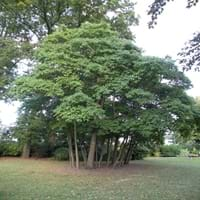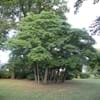Life Span
Perennial
Perennial
Type
Tree
Flowering Plants, Fruits, Herbs
Origin
North America, Northeastern United States, Mid-Atlantic United States, Southeastern United States, Central United States, South-Central United States, Texas, Canada
Australia, Tropical Indomalaya
Types
Not Available
Cavendish Bananas, Lady Finger Bananas, Pisang Raja, Williams Bananas, Cooking Bananas
Number of Varieties
Not Available
Habitat
Dappled Shade, Sunny Edge, Woodland Garden Canopy
Subtropical climates, Tropical rainforest, Tropical regions
USDA Hardiness Zone
3-9
8-15
Sunset Zone
Not Available
H1, H2, 2a, 2b, 3a, 3b, 4, 5, 6, 7, 8, 9, 14, 15, 16, 17, 18, 19, 20, 21, 22, 23, 24
Habit
Oval or Rounded
Upright/Erect
Flower Color
Yellow green, Chartreuse
Burgandy, Ivory, Purple, White, Yellow
Flower Color Modifier
Bicolor
Not Available
Fruit Color
Green, Indigo, Black
Red, Yellow, Yellow Brown, Yellow green
Leaf Color in Spring
Green
Dark Green
Leaf Color in Summer
Green
Green
Leaf Color in Fall
Yellow, Red, Orange, Yellow green, Bronze, Orange Red
Green
Leaf Color in Winter
Not Available
Green
Leaf Shape
Ovate
Cone shaped
Plant Season
Spring, Summer, Fall
Fall, Spring, Summer
Sunlight
Full Sun, Partial Sun
Full Sun, Partial shade
Type of Soil
Clay, Loam, Sand
Clay, Loamy
The pH of Soil
Acidic, Neutral, Alkaline
Neutral, Slightly Acidic
Soil Drainage
Average
Well drained
Bloom Time
Spring
Early Fall, Early Summer, Late Spring, Late Summer, Summer
Tolerances
Not Available
Not Available
Where to Plant?
Ground
Ground
How to Plant?
Seedlings
From bulbs
Plant Maintenance
Medium
Medium
Watering Requirements
Average Water Needs, Do Not over Water
Allow soil to be completely dry in between waterings, It cannot sustain wet-feet, Requires regular watering, Water every two or three days during warmer months
In Summer
Lots of watering
Lots of watering
In Spring
Moderate
Moderate
In Winter
Average Water
Average Water
Soil pH
Acidic, Neutral, Alkaline
Neutral, Slightly Acidic
Soil Type
Clay, Loam, Sand
Clay, Loamy
Soil Drainage Capacity
Average
Well drained
Sun Exposure
Full Sun, Partial Sun
Full Sun, Partial shade
Pruning
Remove damaged leaves, Remove dead branches, Remove dead leaves
Prune after harvesting, Remove dead or diseased plant parts
Fertilizers
Nitrogen, Phosphorous
All-Purpose Liquid Fertilizer
Pests and Diseases
Foliage diseases
Anthracnose, Banana aphid, Banana mosaic, Black sigatoka, Bunchy top, Cigar end rot, Coconut scale, Moko disease, Panama disease, Rhizome rot, Yellow sigatoka
Plant Tolerance
Drought
Drought
Flowers
Insignificant
Yes
Flower Petal Number
Single
Single
Fragrant Bark/Stem
Yes
No
Foliage Texture
Medium
Bold
Foliage Sheen
Matte
Glossy
Attracts
Insects
Not Available
Allergy
Dermatitis, Diaphoresis
Anaphylaxis, Mouth itching, Throat itching
Aesthetic Uses
Not Available
Not Available
Beauty Benefits
Skin Problems
Not Available
Environmental Uses
Air purification
Air purification
Medicinal Uses
Alterative, Anodyne, Antirheumatic, Antiseptic, Carminative, Diaphoretic, Diuretic
Anemia, Antioxidants, Bronchitis, Diarrhea, Hangover, Heartburn, High blood pressure, Kidney problems, Menstrual Disorders
Part of Plant Used
Leaves
Flowers, Fruits
Other Uses
Used as a condiment, Used in making tea, Used to flavour soups
Pulp can be used to make rope place mats and other goods, Used As Food, Used in paper industry
Used As Indoor Plant
No
No
Used As Outdoor Plant
Yes
Yes
Garden Design
Shade Trees, Street Trees
Showy Tree
Botanical Name
SASSAFRAS albidum
Banana Tree
Common Name
Sassafras
Banana Tree
In Hindi
Sassafras
केले के पेड़
In German
Sassafras
Bananenbaum
In French
Sassafras
Bananier
In Spanish
Sasafrás
Banano
In Greek
σασάφρα
μπανανιά
In Portuguese
sassafrás
árvore de banana
In Polish
Sassafras
Banana drzewa
In Latin
Sassafras
Musa sapientum fixa ligno
Phylum
Magnoliophyta
Magnoliophyta
Class
Magnoliopsida
Liliopsida
Order
Laurales
Zingiberales
Family
Lauraceae
Not Available
Clade
Angiosperms, Magnoliids
Monocotyledonous
Tribe
Cinnamomeae
Not Available
Subfamily
Lauroideae
Not Available
Importance of Sassafras and Banana Tree
Want to have the most appropriate plant for your garden? You might want to know the importance of Sassafras and Banana Tree. Basically, these two plants vary in many aspects. Compare Sassafras and Banana Tree as they differ in many characteristics such as their life, care, benefits, facts, etc. Every gardener must at least have the slightest clue about the plants he wants to plant in his garden. Compare their benefits, which differ in many ways like facts and uses. The medicinal use of Sassafras is Alterative, Anodyne, Antirheumatic, Antiseptic, Carminative, Diaphoretic and Diuretic whereas of Banana Tree is Anemia, Antioxidants, Bronchitis, Diarrhea, Hangover, Heartburn, High blood pressure, Kidney problems and Menstrual Disorders. Sassafras has beauty benefits as follows: Skin Problems while Banana Tree has beauty benefits as follows: Skin Problems.
Compare Facts of Sassafras vs Banana Tree
How to choose the best garden plant for your garden depending upon its facts? Here garden plant comparison will help you to solve this query. Compare the facts of Sassafras vs Banana Tree and know which one to choose. As garden plants have benefits and other uses, allergy is also a major drawback of plants for some people. Allergic reactions of Sassafras are Dermatitis and Diaphoresis whereas of Banana Tree have Anaphylaxis, Mouth itching and Throat itching respectively. Having a fruit bearing plant in your garden can be a plus point of your garden. Sassafras has no showy fruits and Banana Tree has showy fruits. Also Sassafras is not flowering and Banana Tree is flowering. You can compare Sassafras and Banana Tree facts and facts of other plants too.





